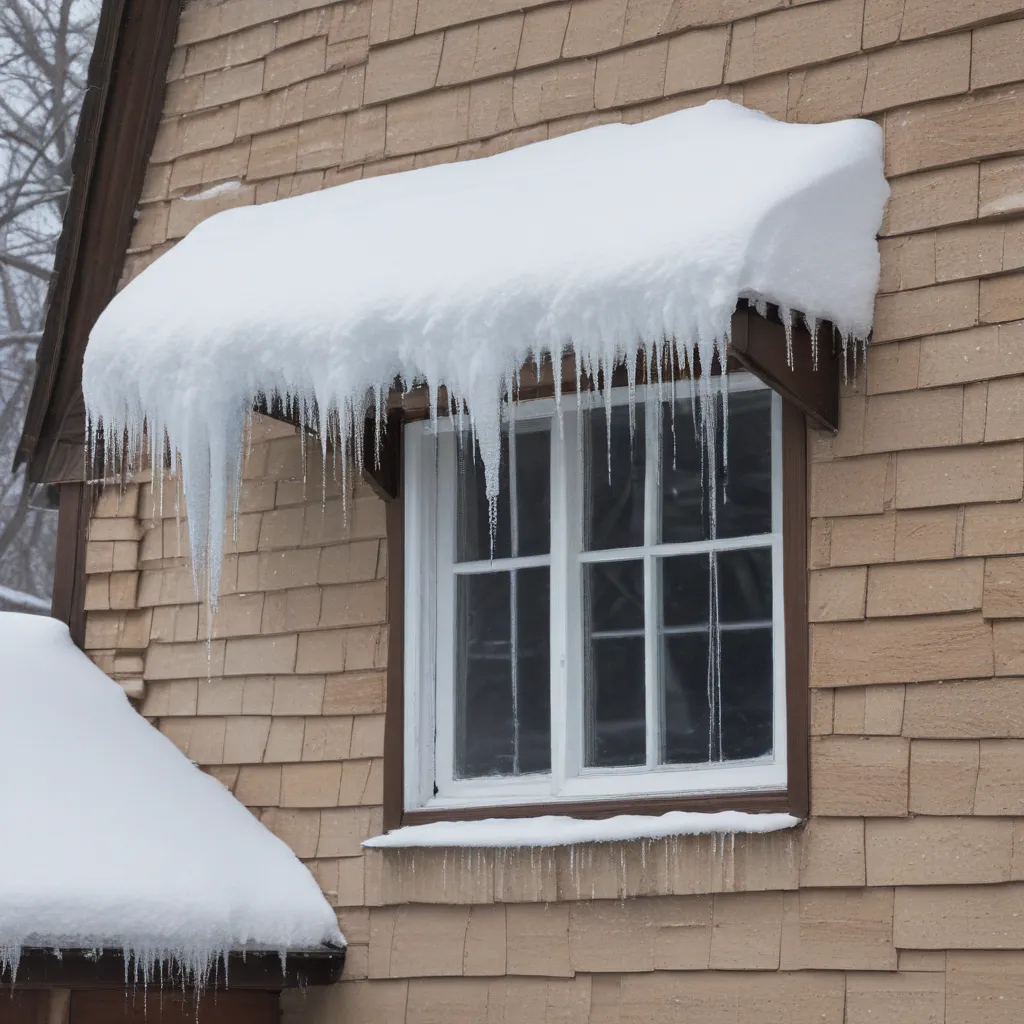
The Perils of Ice Dams: A Wintertime Nightmare
As a lifelong Texan, I’ll admit that I used to roll my eyes every time the weatherman warned about the dreaded “ice dams.” After all, how much of a problem could a little frozen water be in our mild, sunny climate, right? Well, that was before I got into the roofing business and saw firsthand the havoc that ice dams can wreak on homes in the Allen area.
You see, I used to think ice dams were just a nuisance – an ugly icicle hanging off the eaves, maybe causing a little leakage. Boy, was I wrong. These insidious formations can cause thousands of dollars in damage, from ruined insulation and rotting wood to collapsing ceilings and flooded interiors. And the kicker? A lot of that damage is preventable with proper roof ventilation.
Understanding the Anatomy of an Ice Dam
To understand how ventilation stops ice dams, we first need to know how they form. It all starts with heat escaping from the attic. During the winter, warm air from the living spaces below seeps up into the attic, where it meets the cold outdoor air. This temperature differential causes snow on the roof to melt.
The water then flows down the roof slope until it reaches the eaves, which are typically colder since they extend beyond the insulated living space. There, the water refreezes, creating a dam of ice that traps more water behind it. This pooled water can then work its way under the shingles and into the home, causing all sorts of problems.
The Ventilation Solution
So how does proper ventilation stop this vicious cycle? It all comes down to maintaining a consistent temperature across the entire roof surface. You see, when an attic is well-ventilated, the warm air is efficiently whisked away before it can melt the snow on the roof. This prevents the temperature differential that leads to ice dam formation in the first place.
Ideally, you want a balanced system of intake vents (like soffit or eave vents) and exhaust vents (like ridge or gable vents) that creates a smooth, even airflow across the attic. This airflow not only stops ice dams, but also helps regulate the attic temperature year-round, improving energy efficiency and preventing other roofing issues like mold, mildew, and premature shingle deterioration.
The Science Behind Effective Ventilation
Now, I know what you’re thinking – “That all sounds great, but how exactly does it work?” Well, let me break it down for you in a bit more detail.
The key is maintaining what’s known as the “thermal boundary” – the barrier between the conditioned living space and the unconditioned attic. When this boundary is intact, the warm air stays down below where it belongs, and the cold air stays up top. But when that boundary is compromised, either through poor insulation or inadequate ventilation, the warm air escapes upward, melting the snow.
By installing the right combination and placement of intake and exhaust vents, we create a continuous flow of fresh, cold air across the entire attic space. This removes the warm air before it can reach the roof deck and cause problems. It’s like having a giant, invisible fan up there, pushing the hot air out and pulling the cold air in.
Real-World Examples of Ventilation Done Right (and Wrong)
Of course, the proof is in the pudding. Let me share a few examples from my years in the Allen roofing business to really drive the point home.
I’ll never forget the time I got a call about a massive ice dam that had formed on a brand-new custom home. The homeowners had spared no expense, but they skimped on the attic ventilation. All that warm air from their state-of-the-art HVAC system was simply pouring into the attic, melting the snow and creating a disastrous ice dam that caused thousands in water damage.
Contrast that with a client of ours who had an older home that was prone to ice dams. We did a full ventilation overhaul, adding soffit vents, ridge vents, and strategically placed exhaust fans. Lo and behold, the very next winter, they didn’t have a single icicle hanging from the eaves. The snow stayed pristine, and they avoided any leaks or other issues.
Proper Ventilation: An Investment in Your Home’s Future
Look, I know dealing with ice dams can be a real pain. But trust me, addressing the root cause through proper ventilation is going to save you a whole lot of headaches (and money) down the line. It’s one of those home maintenance tasks that’s easy to overlook, but can pay huge dividends when done right.
Think about it – a well-ventilated attic doesn’t just prevent ice dams. It also helps regulate temperature, improve energy efficiency, and protect the structural integrity of your roof. That’s an investment that keeps on giving, year after year.
So if you’re dealing with ice dams or want to be proactive about protecting your home, I highly encourage you to consider a comprehensive ventilation assessment and upgrade. It may not be the most glamorous project, but trust me, your future self (and your wallet) will thank you.
And hey, if you’re in the Allen, Texas area, you know where to find us. Our team of roofing experts would be more than happy to evaluate your ventilation system and recommend the best solutions to keep those pesky ice dams at bay. Stay warm out there, y’all!
